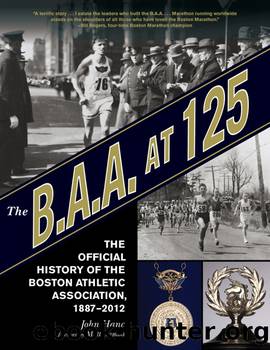The B.A.A. at 125 by John Hanc

Author:John Hanc
Language: eng
Format: epub
Publisher: Sports Publishing
Published: 2012-01-15T00:00:00+00:00
; The 1913 indoor track team poses outside of B.A.A. headquarters. George V. Brown is at far left, standing.
B.A.A. athletes in action in a track meet on Boston Common, 1915 (above) and in 1916 at Russell Field in Cambridge (below.)
In hockey, George found a new ally at the B.A.A. In some ways, Henry G. Lapham was a prototypical member: he traveled in elite circles, belonged to other major clubs, and knew his way around a banquet hall. But Lapham was hardly a Brahmin. He was born in Brooklyn, not Brookline; he was a Yalie, not a Harvard man. And while many of the B.A.A. members hailed from families whose wealth dated back generations, Lapham was the scion to a twentieth century-style fortune, one based in oil. His father, Lewis, was a cofounder of the Texas (now Texaco) Oil Corporation.
Brown convinced Lapham to help fund the B.A.A. team. As hockey historian Stephen Hardy notes, the connection between the two represents âthe opportunities the still-young sport industry offered a man like Brown.â It also showed again Georgeâs ability to work with men of every social strata and background to achieve his goals.
The Unicornsâdominated by former Harvard playersâproved to be an easy team to hate. A rival Boston club called the Intercolonials was formed, Hardy writes, âexpressly to defeat the B.A.A.â In 1912 the two teams faced off a pair of epic games. The first matchâdescribed by the Boston Herald as âforty minutes of slashing play which kept the big crowd thrilledââended in a tie. In a rematch for what was called the âChampionship of the State,â the B.A.A. won a taut 1-0 victory, marked by ârough attacks,â players âspilled about the surface,â and sticks âflying in all directions.â
Big-time hockey had arrived in Bostonâ with George V. and the B.A.A. right in the middle of it. Brown would continue his involvement in hockey (and his partnership with Lapham) as manager of the both the Boston Arena and later, the Boston Garden. He is considered a pioneer of the sport and was enshrined in the Hockey Hall of Fame in Toronto in 1961.
Brown had a career in college athletics as well. In fact, he helped create the Athletic Department at Boston University. At the time, B.U. had not yet moved to its Charles River campus, and was scattered in buildings around Boston, including some in Copley Square near the B.A.A. headquarters. âI used to watch the boys at BU playing baseball and other games in that long, winding alley separating the B.A.A. [headquarters] on Exeter Street from the BU buildings,â he recalled in an interview with columnist Jack Conway. âOne day, I got up my courage to a point where I called upon the president of BU. I told him he should have an athletic field for his university.â This, he admitted, âwas rather radical. I was told that colleges didnât have athletic fields. I persisted in my arguments. The final result was the B.A.A. [gave] BU a splendid little field in Riverside. I am glad I was able to raise $50,000 to pay for the land.
Download
This site does not store any files on its server. We only index and link to content provided by other sites. Please contact the content providers to delete copyright contents if any and email us, we'll remove relevant links or contents immediately.
Annapurna by Maurice Herzog(3403)
Liar's Poker by Michael Lewis(3330)
A Forest Journey by John Perlin(3012)
Atlas Obscura by Joshua Foer(2768)
The Ogre by Doug Scott(2606)
Cuba by Lonely Planet(2533)
Photographic Guide to the Birds of Indonesia by Strange Morten;(2469)
Tokyo by Rob Goss(2348)
All Things Reconsidered by Bill Thompson III(2333)
The Splendid and the Vile by Erik Larson(2307)
A TIME OF GIFTS by Patrick Leigh Fermor(2136)
INTO THE WILD by Jon Krakauer(2135)
Fatal Storm by Rob Mundle(2111)
Trail Magic by Trevelyan Quest Edwards & Hazel Edwards(2109)
DK Eyewitness Top 10 Travel Guides Orlando by DK(2082)
Top 10 Dubai and Abu Dhabi by DK Travel(2035)
Abbey in America by Murray John A(2032)
Touching the Void by Joe Simpson(2024)
Lonely Planet Australia by Lonely Planet(2009)
